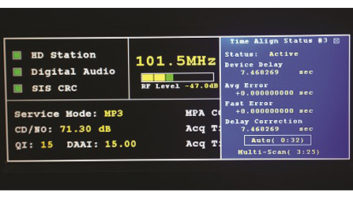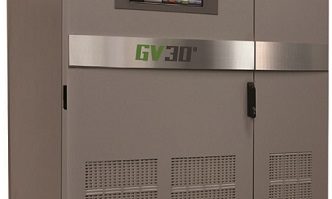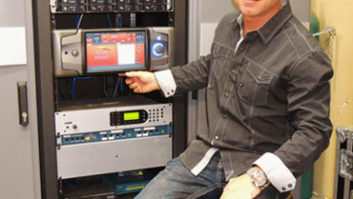Field Report: Omnia One
Mar 1, 2011 1:00 AM, By Mike Kernen
It’s been a long time since I ended the practice of stacking processors in the transmission audio chain. So long that when this need arose I found myself waxing nostalgic about boxes like the Texar Audio Prizm with its requisite Orban card 5 hotrod. I’ve often added boxes on both sides of the core audio processor: Modulation Sciences composite clippers, Orban XT chassis, UREI 1176s, and the Aphex Compellor, to name a few. Always the goal was to attain dial presence and consistent listenable sound. With digital processors, everything changed. Now the stations’ sound could be treated, molded, pumped up and sent — all within one box.

Robert C. Gallagher once mused: “Change is inevitable — except from a vending machine.” Audio processors are no exception. DSP advances give processor designers access to ever-increasing power with no end in sight. Like most radio stations, we change processors within reason to remain competitive and to deliver a cleaner more listenable sound to our audience. This too is the goal among processing manufacturers. The full-blown audio processor has become a very complicated, albeit powerful unit where an engineer can find himself bogged down with literally hundreds of controls and options.
The Omnia One is not such a processor. It is designed to lower cost, guesswork, confusion and space requirements. It also offers itself to a variety of applications. The Omnia One can be used as a radio station’s main processor: It includes an excellent stereo generator – the same one used in the Omnia 5EX and 6EX, an SCA/RDS input, a distortion cancelled final clipper, and so says Omnia, “the same processing topology that made the original Omnia FM famous.”
Flexibility built in
Performance at a glanceIP GUI remote control
Digital and analog I/O
Wide-band AGC, four-band AGC and four-band limiter
Digital peak-controlled stereo generator
Single-knob operation
LCD and peak bar graph metering
The One is incredibly versatile. It can be used as a main processor for AM or FM, as an adjunct to a full-feature box, as a studio processor, a multicast processor, or a Web stream processor. It even offers a different firmware load for each such application. Should you decide to repurpose your One, simply download the firmware file for the flavor you now need.
I’ve chosen to use my processor for yet another task. Arbitron’s PPM system offers new challenges to programmers and engineers alike. Of primary concern is the need to present the PPM encoder with an audio signal that is full and consistent. Since my main processors do not have a side-chain I/O where the PPM encoder could be inserted after the AGC, I needed to add something completely separate ahead of the PPM encoder. What I needed was simple audio consistency so I considered many of the old standbys — the UREI, the Aphex, 8200ST and even the old CBS Volumax 410 crossed my mind. Of course none of those would work in this application because our audio chain is entirely AES digital. Furthermore, to use one of those units, I’d also need to add a D/A-A/D converter. This was indeed the wrong approach. A search of the Internet turned up exactly zero modern studio style audio processors with AES-EBU I/O. What to do?
— continued on page 2
Field Report: Omnia One
Mar 1, 2011 1:00 AM, By Mike Kernen
Finally eliminating all of the semi-pro musician friendly boxes, I discovered the Omnia One. Omnia knows its customers are pros who need professional I/O. Not only does it include AES digital (Radio Systems’ Studio Hub compatible), but it also offers balanced analog I/O and can even become a node in an Axia Livewire AoIP network environment. It has an excellent Web-based remote control, is rack mountable, priced right and can easily be configured to ride gain or to rock the house. Its easy to use single-knob control is immediately familiar and the displays are simple, clear and adequately verbose. If that’s not enough, did I mention that its sound is first-rate, too? I auditioned nearly every preset and am impressed. The One can be big or small, thick or thin, tall, grande or venti. I also put the thing on the air for a while and I can say that it really gets it done!
Omnia AudioP
W
E 216-241-3343
www.omniaaudio.com
[email protected]
Setting the One apart from its musician-targeted brethren are features like a Web remote interface, user and preloaded factory presets, the ability to store and recall I/O setups, of course the stereo generator and associated composite audio capabilities, automatic input failover, and immediately noticeable is the designer’s familiarity with the handsome and professional radio engineer.
I almost feel guilty giving the wholly capable processor the prosaic task of riding levels for the PPM encoder. The unit seems almost too good for such yeoman’s work. A welcome side effect of its installation is that our programming department loves the sound. I sleep better knowing that the PPM system is now spitting out more codes than ever before. At least that’s the theory.
The folks at Omnia are right to point out just how dead center they’ve hit the bull’s eye with the processor. The fact that they’ve now sold more than 5,000 units speaks not only to the unit’s broad appeal, but tells a story of a marketplace that needed this particular product at this price point. You can see why they’ve chosen the tagline “Everybody wants One!” I suspect I’ll always need One more.
Kernen is the chief engineer of WCSX, WRIF and WMGC, Greater Media Detroit.
Editor’s note: Field Reports are an exclusive Radio magazine feature for radio broadcasters. Each report is prepared by well-qualified staff at a radio station, production facility or consulting company.
These reports are performed by the industry, for the industry. Manufacturer support is limited to providing loan equipment and to aiding the author if requested.
It is the responsibility of Radio magazine to publish the results of any device tested, positive or negative. No report should be considered an endorsement or disapproval by Radio magazine.
March 2011
Get ready for the 2011 NAB Show with our convention preview, as well as details on using SNMP, a tour of Alpha Broadcasting, and Field Reports on the Omnia One and Halo Audio Affinity….
Omnia Audio Omnia.11
Audio processor…





